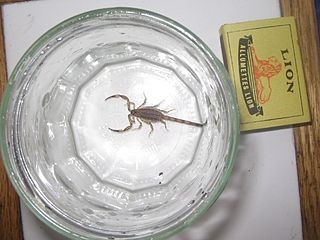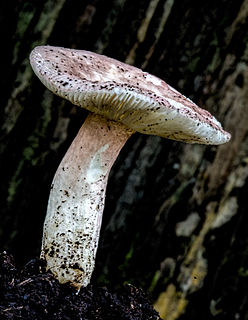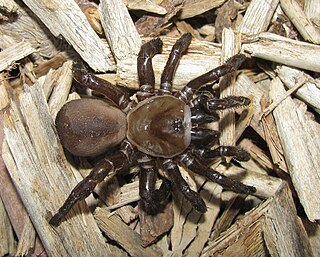
Tiger snakes are a large and highly venomous snake of southern Australia, including its coastal islands and Tasmania. These snakes are often observered and locally well known by their banding, black and yellow like a tiger, although the species can be highly variable in coloration and patterning. All populations are classified within the genus Notechis (Elapidae), their diverse characteristics have been classified either as distinct species or by subspecies and regional variation.

Aphonopelma is a genus of tarantulas native to the Americas. It includes nearly all the North American tarantula species north of Mexico and a considerable percentage of the tarantula species that range into Central America. Most are fairly large tarantulas with leg spans of 6 in (16 cm) or more. Like most New World tarantulas, all species of Aphonopelma have urticating hairs. Despite their fearsome appearance, these tarantulas are not harmful to humans and some species are popular in the pet trade. With about 90 species described so far, Aphonopelma comprises about 10% of the total number of described tarantula species. However, their taxonomy is poorly understood and species are difficult to tell apart, especially those that are brown or black without other pattern. Therefore, the actual number of species is unknown, with more species likely to be identified in the near future. In captivity, they are usually fed crickets; in the wild, they eat most insects, including crickets, grasshoppers, cockroaches, mantises, and beetles.

Neon is a spider genus of the jumping spider family, Salticidae. Its described species occur mostly in Eurasia, with some species found in North and South America. One species, N. convolutus, is also found in Algeria. Two species are known from Australia, N. australis and N. taylori. N. australis has palp morphology and fringing on its first pair of legs very similar to that seen in N. nojimai Ikeda 1995, from Japan. N. taylori is most similar in morphology to N. sumatranus from Indonesia and N. kovblyuki from the Crimea and elsewhere. The genus is common and widespread in litter throughout Australia, from the highlands of Tasmania through the hot, dry inland to the wet tropics and includes many undescribed species.

Red-bodied swallowtails or ruby swallowtail are butterflies in the swallowtail family, that belong to the genera Atrophaneura, Byasa, Losaria, or Pachliopta. They are generally found in Asia.

The pygmy long-eared bat is a vespertilionid bat, found in the north of the Australian continent. An insectivorous flying hunter, they are one of the tiniest mammals in Australia, weighing only a few grams and one or two inches long.

Butis butis, the crazy fish, duckbill sleeper, or upside-down sleeper, is a species of sleeper goby that are native to brackish and freshwater coastal habitats of the Indian Ocean and the western Pacific Ocean from the African coast to the islands of Fiji. They prefer well-vegetated waters and can frequently be found in mangrove swamps. They are small, drably-colored fish, reaching a maximum length of only 15 cm (5.9 in). They are predatory and are known for their behavior of swimming vertically – or even upside down – while hunting.

Derbidae is a family of insects in the order Hemiptera, the true bugs. It is one of the largest and most diverse families of planthoppers. It is widely distributed around the world, especially in the tropics, and with many species in subtropical and temperate regions.

Douglas Hamilton McLean was an Australian-born rower who rowed in the Boat Race five times and won Silver Goblets at Henley Royal Regatta. He was also a cricketer who played one match for Somerset in 1896. McLean was born in Sydney, the son of John Donald McLean, colonial treasurer of Queensland, Australia. He went to England where was educated at Eton College and made his first appearance at Henley in the Eton eight winning the Ladies' Challenge Plate in 1882. He went on to New College, Oxford where he rowed in the Oxford crew in the Boat Race five times between 1883 and 1887, winning the 1883 and 1885 races. He won the University Pairs for New College in 1885 and also Silver Goblets at Henley with his brother, Hector McLean. In 1886 the McLean brothers were beaten in the final of the Silver Goblets by Stanley Muttlebury and Fraser Churchill. McLean was Australia in December 1886 when he played a match for Geelong Cricket Club and then in India at the start of 1887, but returned in time to take part in his fifth boat race. During the race McLean's oar broke. Oxford were behind at Barnes Railway Bridge, but Cambridge moved into rougher water too far over to the Surrey bank and Oxford were expecting to push through when the disaster struck. Guy Nickalls, then in his first Boat Race, recorded "Then, 'Ducker' McLean broke his oar off short at the button. With the station in our favour and him out of the boat we could have won even then, but 'Ducker' funked the oncoming penny steamers and, instead of jumping overboard as he should have done, we had to lug his now useless body along, to lose the finish." At Henley the McLeans were again runners up in Silver Goblets to Muttlebury and Charles Theodore Barclay.

Perizoma is a genus in the geometer moth family (Geometridae). It is the type genus of tribe Perizomini in subfamily Larentiinae. The tribe is considered monotypic by those who include the genera Gagitodes, Martania and Mesotype in Perizoma. Some other less closely related species formerly placed here are now elsewhere in the Larentiinae, e.g. in Entephria of the tribe Larentiini.

Cerberilla is a genus of sea slugs, aeolid nudibranchs, shell-less marine gastropod mollusks in the family Aeolidiidae.

Isometrus is a genus of scorpion belonging and being eponymous to the family Buthidae. Some species are currently assigned to the genus Reddyanus.
The Euctenizidae are a family of mygalomorph spiders. They are now considered to be more closely related to Idiopidae.

Russula lenkunya is a mushroom in the genus Russula. Found in South Australia, it was first described scientifically by mycologist Cheryl Grgurinovic in 1997.

Caenoplana is a genus of land planarians from Australia and New Zealand.

Australoplana also known as Australian flatworm is a genus of land planarians from Australia and New Zealand.

Kontikia is a genus of land planarians native from islands in the Indo-Pacific region, but several species have been introduced elsewhere.
Reomkago is a genus of land planarians from Australia.

Fletchamia is a genus of land planarians from Australia.
Anisorhynchodemus is a genus of land planarians of the tribe Rhynchodemini. It was erected to include species lacking sufficient morphological information to allow them to be classified in the appropriate genus.

Halonoproctidae is a family of mygalomorph spiders, split off from the family Ctenizidae in 2018. Species in the family are widely distributed in North and Central America, Australasia, Asia, southern Europe and North Africa. One species is recorded from Venezuela in South America. They are relatively large, sombrely coloured spiders, that live in burrows with some kind of trapdoor.
















